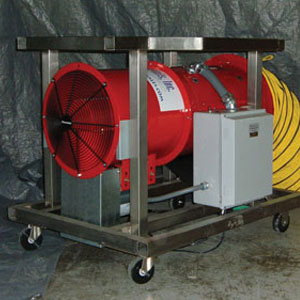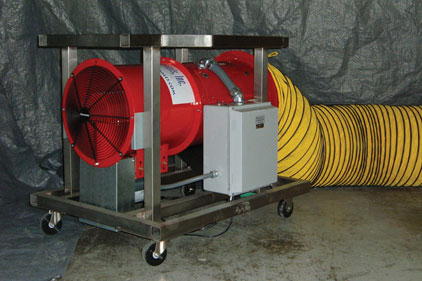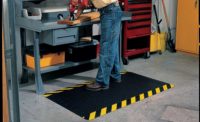-
portable heating technologies available for emergency,
-
temporary and supplemental use,
- how to decide on the best solution for your needs.
There are a number of portable heating options available today for industrial applications.
Start by defining what you hope to achieve with portable heating. Keeping workers warm for their health, comfort and productivity should be the paramount goal, but there may be other considerations too. Do you need to deliver heating to a process that requires a certain minimum temperature level? Are you trying to keep pipes from freezing and bursting? Are you looking to deliver nighttime or weekend heating to a specific area when the main plant is shut down? These considerations might impact the type of heating you will need and where it should be placed.

|
|
Electric heater uses a forced air fan to blow fresh, warm air to the area to be heated, delivering clean, dry air with no emissions. |
Does your facility have a combustible dust issue? Some portable heaters use open flames, which could ignite explosive dust particles — so in these instances, a 100-percent clean, safe, flame-free heat source will be required. What is the best type? If it utilizes gas, where will the gas come from?
What is the net heating effect that will be required? Even if you know the general cfm requirement, the local climate and desired temperature will impact your heating demand. You will also have to allow for other heating sources in the building, heat loss generated by windows, lack of insulation, etc. What is the available power supply? Should fans be incorporated to push hot air down to the ground or to help heat circulation?
Avoid a cookie-cutter approach to equipment selection. Every situation is unique. Call in a portable heating supplier who offers a full range of technologies to perform a site survey and recommend the safest and most efficient solution for your needs.
Types of portable heaters
Direct fired heaters — With direct fired units, air is blown across a natural gas or propane flame into the area to be heated. Though highly efficient and cost-effective, direct fired heaters have an open flame which could produce some level of water vapor and toxic emissions if starved of air, so they should never be used in a sealed indoor environment. In outdoor areas (i.e., tents, construction sites) or well-ventilated spaces such as a manufacturing or warehouse space where there is adequate ventilation, they are a viable choice for temporary heating. These units typically feature very large capacities of 400,000–7,000,000 BTU/hr.
Electric heaters use resistive heat, which is effective in cold environments but is the most expensive form of heat you can get. Large electric heaters offer capacities of 5,000– 512,000 BTU/hr. They use a forced air fan to blow or duct fresh, warm air to the area to be heated, delivering clean, dry air with no emissions. These heaters usually require 3-phase 220 V or 460 V high-voltage wiring for larger spaces, which may not be available — sometimes necessitating the use of a generator or an electrician due to the high current consumption.
Indirect fired heaters have been gaining popularity due to the combined benefits of enhanced fire safety, no possible harmful emissions, and the ability to heat outdoor or indoor industrial spaces.
These powerhouses generate a high amount of heat (ranging from about 100,000–1,500,000 BTU/hr capacity) and are user-friendly.
Indirect fired heaters incorporate a heat exchanger fueled by natural gas, propane, diesel or kerosene. The flame is encapsulated within the heat exchanger, and the fumes are vented outside through a flue pipe on the top of the unit similar to a residential furnace. Ambient air is heated up by passing over the heat exchanger, thus providing 100-percent fresh, clean air. The indirect fired heater unit can be placed inside or outside the space depending on the preference; but if placed inside the building, the flue pipe will need to be ducted outside. Indirect heaters are self-contained and convenient, and require only standard electrical current to power the fan motors.
Portable heat pumps look identical to the portable A/C units so widely accepted for a host of emergency cooling applications, but with the addition of an electrical/mechanical heating function that is more efficient than resistive electric heating. Portable heat pumps are unique in their ability to provide “two-in-one” cooling and heating functions. Because so many regions of the country have seasonal needs for both cooling and heating, these units can provide a versatile solution.
Portable heat pumps typically range from 1 to 5 tons (or up to about 60,000 BTU) in capacity, so they are not practical for heating large manufacturing areas. In plants with no central heating, they can be used to heat offices, lobbies or conference rooms, or even for spot cooling of industrial processes. Even where there is a permanent, primary heat source, they can address “cold spots” such as corner rooms or spaces that need extra heat due to lack of balance in the central system.
Another limitation of portable heat pumps involves operating temperature ranges. Most heat pumps are air-cooled and require a minimum ambient temperature of 45–55˚F — so the climate must be temperate or another heating source must be available in cooler regions.
Also available are water-cooled portable heat pumps which use water instead of air to reject or absorb heat from refrigerant, thus providing heating or cooling. Water-cooled portables can perform in any ambient temperature as long as the temperature of the water is above 40˚F, offering greater operating range and greater capacity than same-sized air-cooled counterparts, as it is possible to pull heat out of water more readily than out of cold ambient air. They are an excellent choice in the right conditions, but they are limited to use in areas where the municipal water supply is plentiful and economical, or in buildings with closed-loop cooling towers.

